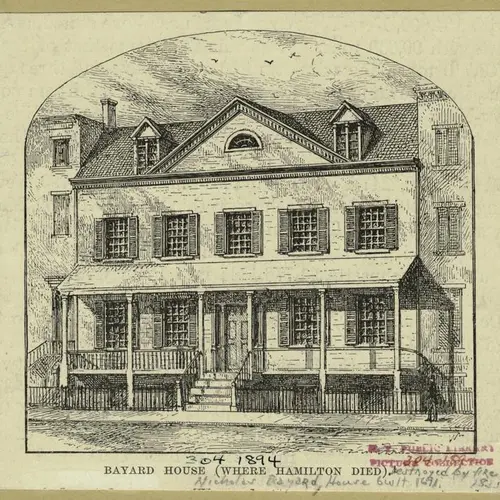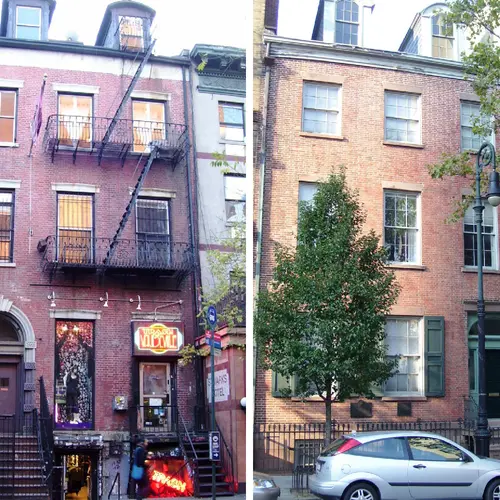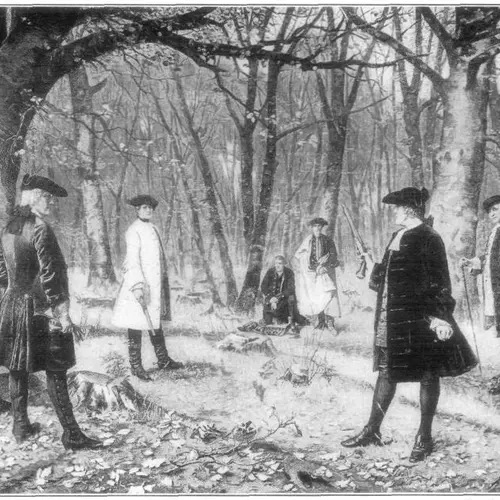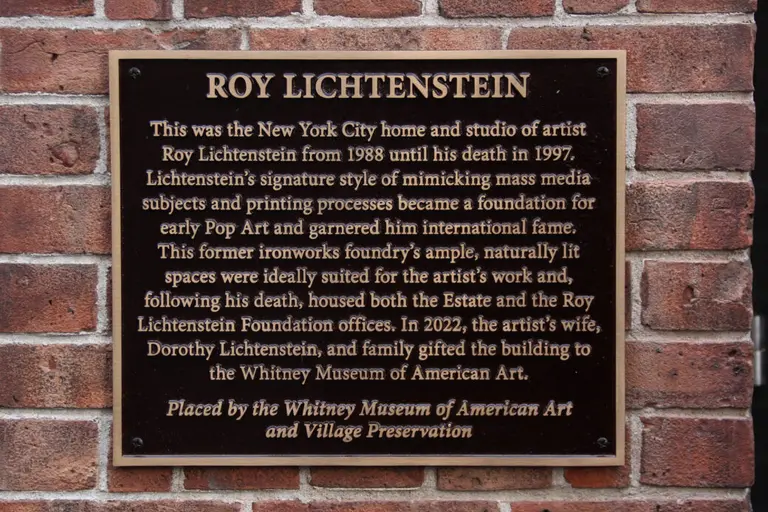Before the duel: Aaron Burr and Alexander Hamilton’s NYC haunts

An illustration of the duel between Alexander Hamilton and Aaron Burr, via Wiki Commons
On July 11, 1804, Aaron Burr and Alexander Hamilton crossed paths for the last time. That was the date of their infamous duel on the cliffs of Weehawken, New Jersey when Burr exacted his long-desired revenge upon Hamilton with a gunshot to the abdomen. But this was not the first time the two men’s lives and careers came in contact. One such place of frequent intersection for the bitter rivals was Greenwich Village – where Burr lived and Hamilton ultimately died. And it’s in Greenwich Village, and the nearby East Village and Soho, where many reminders of these two titanic figures of early American politics can still be found today. Ahead, learn about five sites where Burr and Hamilton made history.
Richmond Hill – Varick, Charlton, King, VanDam and MacDougal Streets
 The Richmond Hill mansion, via NYPL
The Richmond Hill mansion, via NYPL
What was once considered the finest mansion in New York was located near the intersection of present-day Varick and Charlton Streets. It and the surrounding estate, extending from approximately present-day Varick to MacDougal Streets, and Charlton to VanDam Streets, were known as Richmond Hill. Built in 1767, the house served for a time as George Washington and the Continental Army’s headquarters. After the Revolution, it served as the official Vice-Presidential residence of John Adams (New York City was the nation’s first capital), and was soon thereafter purchased by Aaron Burr, who would become the nation’s third Vice-President in 1800. It was from Richmond Hill that Burr departed on the morning of July 11, 1804 for his fateful meeting with Hamilton.
After the duel and Hamilton’s death, Burr became a pariah, eventually fleeing New York. He divided up, developed, and ultimately sold the Richmond Hill Estate, which today forms much of the Charlton-King-VanDam Historic District as well as the southernmost block of MacDougal Street. A reason why so many of the houses in this area date to ca. 1820 is because they were developed in rapid succession once Burr, in cooperation with John Jacob Astor, prepared the land for development.
The Bayard House, north of Jane Street
 The real Bayard House where Hamilton died, via NYPL
The real Bayard House where Hamilton died, via NYPL
Everyone knows that Hamilton was fatally wounded by Burr in their duel. Fewer know that he did not die at the duel, but was taken to the home of his friend William Bayard, within what was then the Bayard Estate (farm) in the northwestern corner of Greenwich Village. It was there that he finally succumbed the following day. The Bayard house has long since been demolished, though Bayard’s son Robert’s house, built in 1854, still stands at 83 Jane Street, on the grounds of the former estate. The existence of the Robert Bayard House across the street may have helped perpetuate the myth that the William Bayard mansion was located at present-day 82 Jane Street, where a plaque affixed to an 1886 tenement claims as much, and that this is the spot where Hamilton died.
There is a grain of truth to this somewhat exaggerated tale. Bayard’s farm’s southern boundary was present-day Jane Street, then a road from which the estate could have been entered. However, the actual mansion was likely located a bit further north, between present-day Horatio and Gansevoort Streets in the West Village.
The Manhattan Well Murder, Spring Street
 129 Spring Street today, via Wiki Commons
129 Spring Street today, via Wiki Commons
Their infamous July 11, 1804 duel was not the first time both Burr and Hamilton were linked by a notorious killing. Both were connected to the first recorded murder trial in America and one of the most sensational trials in New York history.
On December 22, 1799, a young woman named Gulielma “Elma” Sands suddenly disappeared after telling her cousin she was going to meet and secretly marry Levi Weeks, a young carpenter and younger brother to one of New York’s most successful and well-connected builders, Ezra Weeks. Some of Sands’ possessions were found days later in the newly-dug Manhattan Well near today’s Spring Street, and on January 2, 1800, her dead body was removed from the well, with indications she had been choked and thrown down the well. Sands had been seen with Weeks that evening, and a witness claimed to have seen Weeks measuring the well just days earlier.
New York was horrified by the grisly crime and murder of the young girl. But with the help of his influential older brother, Weeks was able to put together a legal “dream team” to defend him, consisting of bitter rivals Hamilton and Burr. Both were likely disinclined to get involved with the case, but Ezra Weeks had leverage with both – Hamilton was indebted to him for the construction of his Upper Manhattan mansion (today’s Hamilton Grange), and Burr’s Manhattan Company actually owned the well in which the body was found and may have wanted to ensure that the defense did not direct any responsibility or blame towards him for the heinous crime.
In spite of the considerable evidence implicating Weeks, Judge John Lansing, citing Hamilton and Burr’s vigorous defense, instructed the jury to find Weeks not guilty. They did so after a mere five minutes of deliberation. Considerable scorn was heaped upon all those involved for the widely criticized decision, particularly by Sands’ family, leading to the legend that those responsible were henceforth cursed.
And the evidence might be said to bear this legend out. Weeks was more or less chased out of the city and lived the rest of his life in Natchez, Mississippi. Judge Lansing disappeared one night after leaving his hotel, never to be seen or heard from again. Hamilton, of course, was killed in his duel with Burr. And Burr was forever tainted by his shooting of Hamilton, tried for treason in 1807, lost his daughter in a hurricane, suffered a terrible stroke, and died penniless on Staten Island.
What is believed to be the remains of the well were uncovered under the foundations of the building at 129 Spring Street in the 1990s, and remains in the cellar of the building to this day.
Bank Street
Speaking of Burr’s Manhattan Company and the Manhattan Well, both had a further connection to Greenwich Village and to Hamilton. In 1798, Burr and his associates endeavored to address the ongoing need for clean drinking water in New York by establishing the Manhattan Company. The business was chartered to supply fresh and safe water to city residents, which was especially needed due to frequent yellow fever outbreaks at the time. But the Manhattan Company’s real purpose was to allow them to create a bank – a rival, in fact, to Hamilton’s Bank of New York – which was difficult to do at the time, but which the loosely written charter for the Manhattan Company allowed Burr to do as an auxiliary function. Hamilton vigorously opposed the founding of Burr’s Bank of Manhattan, adding to their bitter rivalry.
Interestingly, because the Manhattan Company was not primarily interested in supplying safe water, its efforts in that regard were not terribly successful. Partially as a result, outbreaks of yellow fever persisted in the city. One consequence of this was the city’s banks, located on or near Wall Street, moving or setting up branches in the comparatively safer and cleaner Greenwich Village to the north. Both Burr’s Bank of Manhattan and Hamilton’s Bank of New York did so on the same street, which came to be called Bank Street for the concentration of such facilities located there. Burr’s Bank of Manhattan was the predecessor of today’s JP Morgan Chase, while Hamilton’s Bank of New York lead to the formation of today’s BNY Mellon.
The East Village’s Hamilton Houses
 The Hamilton-Holly House (L) via Wiki Commons: The Hamilton-Fish House (R) via Wiki Commons
The Hamilton-Holly House (L) via Wiki Commons: The Hamilton-Fish House (R) via Wiki Commons
While none of Bank Street’s banks still stand, two houses in the East Village still very much carry on the Hamilton name and connection. The Hamilton-Holly House at 4 St. Mark’s Place, formerly the home of punk clothier Trash and Vaudeville, was the longtime home of Hamilton’s widow Elizabeth Schuyler Hamilton, and their two children, Col. Alexander Hamilton Jr. and his wife, and Eliza Hamilton Holly and her husband.
Just a block to the north, the still-standing Hamilton Fish House or Stuyvesant-Fish House at 21 Stuyvesant Street, built in 1804, was the birthplace and longtime residence of Hamilton Fish, the New York Governor and Senator. Fish was named after the recently-killed Alexander Hamilton by his parents, Hamilton’s good friends Nicholas Fish and Elizabeth Stuyvesant. The house is now the residence of the President of Cooper Union.
RELATED:
- How Aaron Burr gave the city a faulty system of wooden water mains
- Contemporary artist buys ‘Aaron Burr House’ in the West Village for $4.8M
- From George Washington to Hudson Square: The history of the Charlton-King-VanDam neighborhood
+++

This post comes from Village Preservation. Since 1980, Village Preservation has been the community’s leading advocate for preserving the cultural and architectural heritage of Greenwich Village, the East Village, and Noho, working to prevent inappropriate development, expand landmark protection, and create programming for adults and children that promotes these neighborhoods’ unique historic features. Read more history pieces on their blog Off the Grid

































